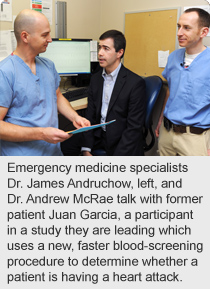
March 26, 2015
Story by Greg Harris; photo by Paul Rotzinger
Juan Garcia, a 45-year-old Calgary engineer who had bypass surgery in 2012, has seen his share of the health system.
One day earlier this year he went to the emergency department at 8 a.m. with chest pains, but it wasn’t until 9 p.m. that doctors were finally able to rule out a heart attack.
“Obviously that period when you’re most anxious is when you’re told, ‘We’re just going to take a blood sample, but you have to wait and sit for six hours when we’ll draw another blood sample, and hopefully within an hour or two of that we’ll get the results,’” says Garcia.
That lengthy waiting period that some cardiac patients experience could one day be significantly shortened, depending on the results of a new research study underway in the emergency department at Foothills Medical Centre.
 Researchers are evaluating the reliability of a new blood-screening procedure that shortens by several hours the time it takes for physicians to rule out a heart attack. If the test proves accurate, not only would it improve care for cardiac patients, it would also improve flow in congested emergency departments.
Researchers are evaluating the reliability of a new blood-screening procedure that shortens by several hours the time it takes for physicians to rule out a heart attack. If the test proves accurate, not only would it improve care for cardiac patients, it would also improve flow in congested emergency departments.
“Patients who arrive at hospital with chest pains are given priority because it is essential for doctors to quickly identify which patients need to be treated for a heart attack,” says Dr. James Andruchow, the lead investigator in the study and a specialist in emergency medicine.
“The only way to confirm that a patient has not had a heart attack is through a blood test called a troponin assay. The current process requires repeat blood tests and can take between six and 12 hours to complete. However, accelerated diagnostic protocols using the new generation of tests could reduce that to as little as one or two hours, and some patients may be safely discharged following the results of a single blood test taken on arrival,” says Andruchow, who is also a clinical assistant professor in the Cumming School of Medicine at the University of Calgary.
Troponin is a protein released into the bloodstream during a heart attack.
Dr. Andrew McRae, a co-investigator and emergency medicine specialist, estimates the four adult acute care emergency departments in Calgary combined see 40 or more patients with possible heart attack symptoms every day.
“It turns out that about 85 per cent of those patients have not experienced a heart attack, but instead have some other condition with similar symptoms, such as heartburn, an upper respiratory infection or muscular chest pain,” says Dr. McRae, who is also an assistant professor in the Department of Community Health Sciences in the Cumming School of Medicine and a member of the O’Brien Institute for Public Health.
“If the new test could get them admitted or safely sent home sooner, it could potentially save thousands of bed hours of emergency department space every month.”
The new generation of troponin tests is 10 times more sensitive than the previous version, which decreases the risk of missed heart attacks. If results are interpreted judiciously, it also has a low risk of increased false positives.
Although the new troponin tests are used in a handful of other jurisdictions in Canada and Europe, the best way of harnessing their higher sensitivity — without increasing false positives — hasn’t yet been established. So far, researchers in the Calgary study haven’t seen a higher rate of false positives.
Garcia, who was subsequently diagnosed with recurring muscle pain that had flared up as a result of his bypass surgery, is one study participant who appreciates the potential benefits of the research.
“Not only would it help the patients in shortening that anxiety period, but it could also clear the emergency area in a faster way,” he says.
Researchers hope to complete data collection by the end of 2015.
Anyone experiencing symptoms of a heart attack should call 911 and seek immediate medical attention. Symptoms often include chest pain or shortness of breath, but can also include nausea, light-headedness, a fast or irregular heartbeat, or pain that spreads to the neck, shoulder or arms.